Google Drive Connector for PowerShell
Read / write Google Drive data inside your app; perform many Google Drive operations without coding, just using easy to use high performance API Connector for Google Drive
In this article you will learn how to quickly and efficiently integrate Google Drive data in PowerShell without coding. We will use high-performance Google Drive Connector to easily connect to Google Drive and then access the data inside PowerShell.
Let's follow the steps below to see how we can accomplish that!
Google Drive Connector for PowerShell is based on ZappySys API Driver which is part of ODBC PowerPack. It is a collection of high-performance ODBC drivers that enable you to integrate data in SQL Server, SSIS, a programming language, or any other ODBC-compatible application. ODBC PowerPack supports various file formats, sources and destinations, including REST/SOAP API, SFTP/FTP, storage services, and plain files, to mention a few.
Create ODBC Data Source (DSN) based on ZappySys API Driver
Step-by-step instructions
To get data from Google Drive using PowerShell we first need to create a DSN (Data Source) which will access data from Google Drive. We will later be able to read data using PowerShell. Perform these steps:
-
Download and install ODBC PowerPack.
-
Open ODBC Data Sources (x64):

-
Create a User data source (User DSN) based on ZappySys API Driver
ZappySys API Driver
-
Create and use User DSN
if the client application is run under a User Account.
This is an ideal option
in design-time , when developing a solution, e.g. in Visual Studio 2019. Use it for both type of applications - 64-bit and 32-bit. -
Create and use System DSN
if the client application is launched under a System Account, e.g. as a Windows Service.
Usually, this is an ideal option to use
in a production environment . Use ODBC Data Source Administrator (32-bit), instead of 64-bit version, if Windows Service is a 32-bit application.
-
Create and use User DSN
if the client application is run under a User Account.
This is an ideal option
-
When the Configuration window appears give your data source a name if you haven't done that already, then select "Google Drive" from the list of Popular Connectors. If "Google Drive" is not present in the list, then click "Search Online" and download it. Then set the path to the location where you downloaded it. Finally, click Continue >> to proceed with configuring the DSN:
GoogleDriveDSNGoogle Drive
-
Now it's time to configure the Connection Manager. Select Authentication Type, e.g. Token Authentication. Then select API Base URL (in most cases, the default one is the right one). More info is available in the Authentication section.
Google Drive authentication
User accounts represent a developer, administrator, or any other person who interacts with Google APIs and services. User accounts are managed as Google Accounts, either with Google Workspace or Cloud Identity. They can also be user accounts that are managed by a third-party identity provider and federated with Workforce Identity Federation. [API reference]
Follow these steps on how to create Client Credentials (User Account principle) to authenticate and access Google Drive API in SSIS package or ODBC data source:
WARNING: If you are planning to automate processes, we recommend that you use a Service Account authentication method. In case, you still need to use User Account, then make sure you use a system/generic account (e.g.automation@my-company.com). When you use a personal account which is tied to a specific employee profile and that employee leaves the company, the token may become invalid and any automated processes using that token will start to fail.Step-1: Create project
This step is optional, if you already have a project in Google Cloud and can use it. However, if you don't, proceed with these simple steps to create one:
-
First of all, go to Google API Console.
-
Then click Select a project button and then click NEW PROJECT button:
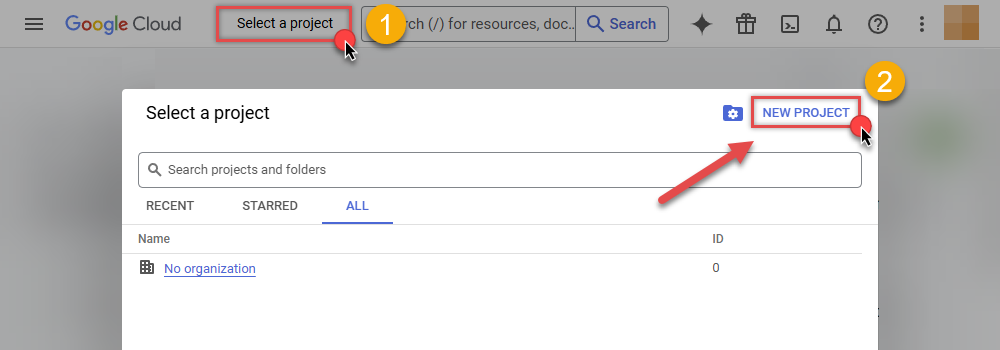
-
Name your project and click CREATE button:
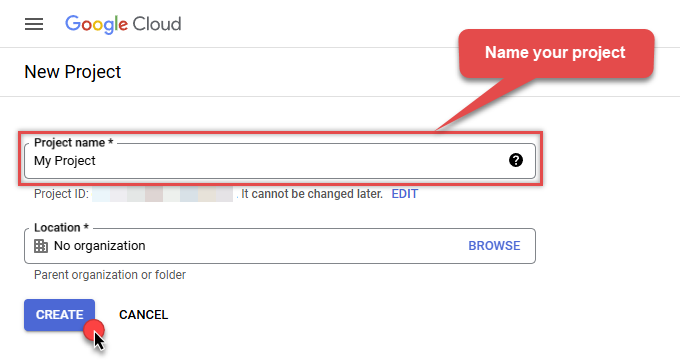
-
Wait until the project is created:
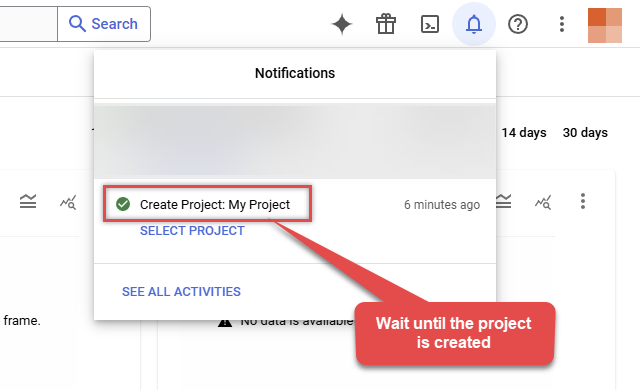
- Done! Let's proceed to the next step.
Step-2: Enable Google Drive API
In this step we will enable Google Drive API:
-
Select your project on the top bar:

-
Then click the "hamburger" icon on the top left and access APIs & Services:

-
Now let's enable several APIs by clicking ENABLE APIS AND SERVICES button:
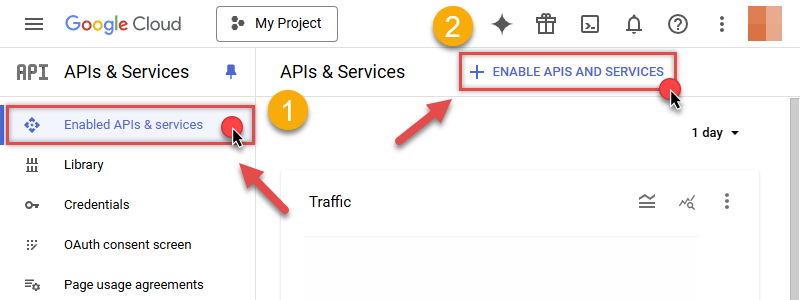
-
In the search bar search for
driveand then locate and select Google Drive API: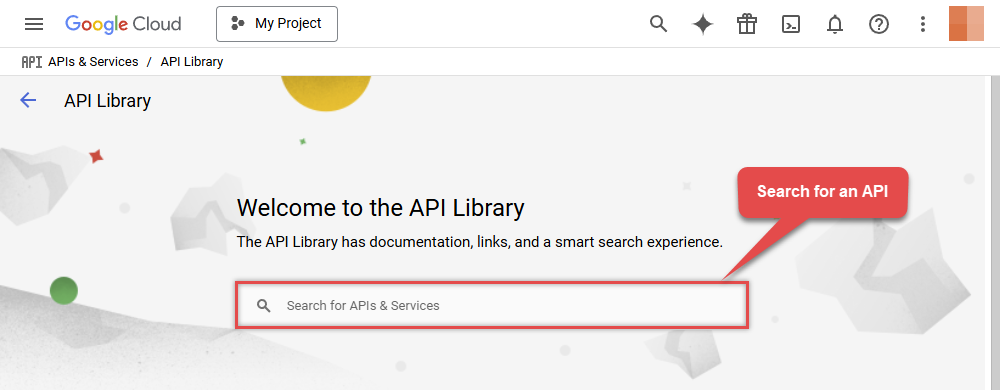
-
Enable Google Drive API:
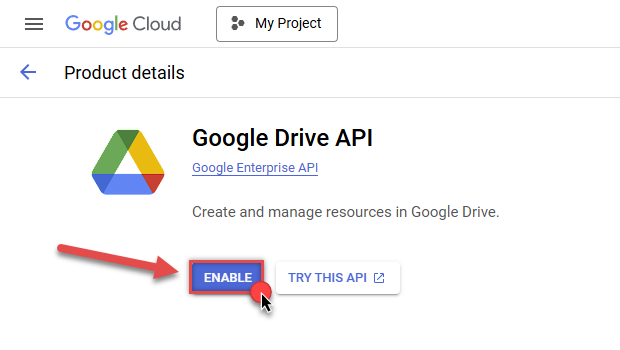
- Done! Let's proceed to the next step.
Step-3: Create OAuth application
-
First of all, click the "hamburger" icon on the top left and then hit VIEW ALL PRODUCTS:

-
Then access Google Auth Platform to start creating an OAuth application:
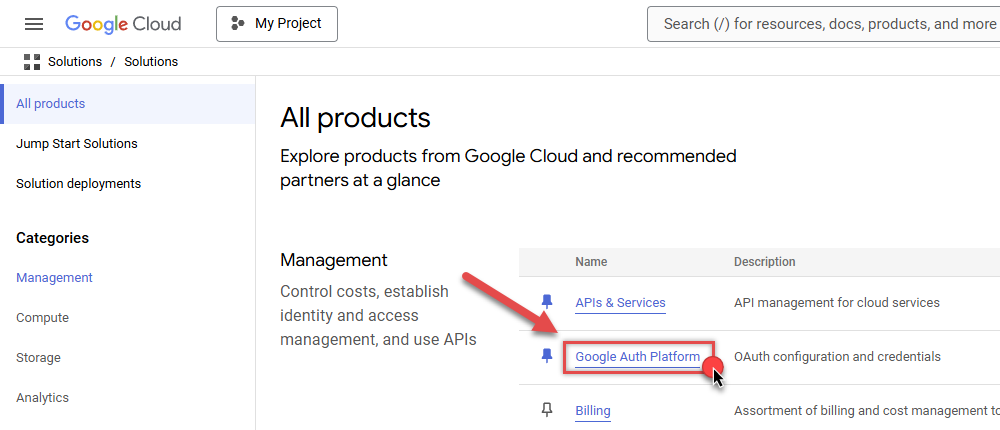
-
Start by pressing GET STARTED button:
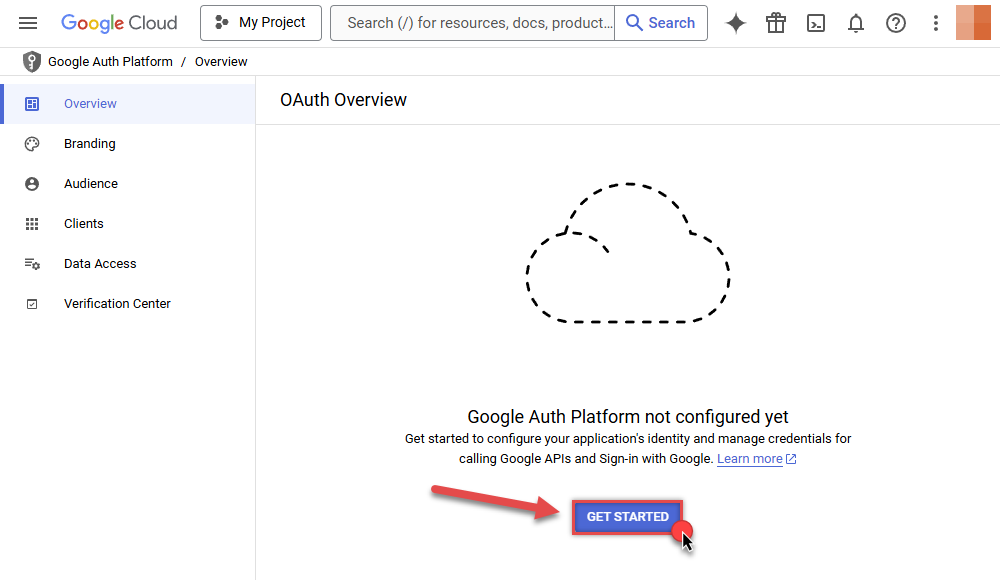
-
Next, continue by filling in App name and User support email fields:

-
Choose Internal option, if it's enabled, otherwise select External:

-
Optional step if you used
Internaloption in the previous step. Nevertheless, if you had to useExternaloption, then click ADD USERS to add a user:
-
Then add your contact Email address:
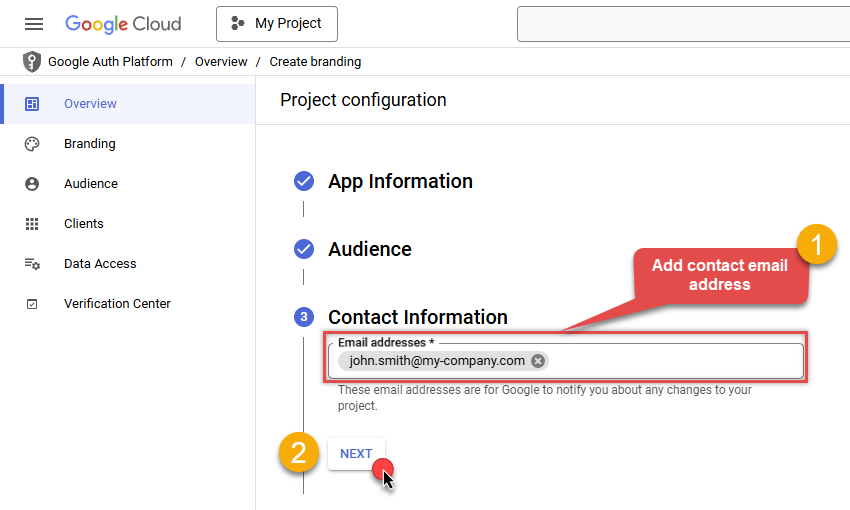
-
Finally, check the checkbox and click CREATE button:
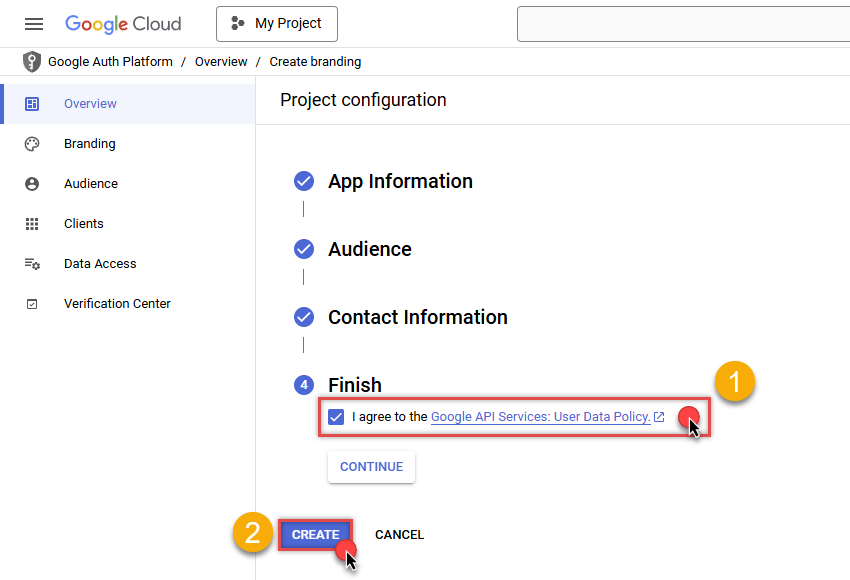
- Done! Let's create Client Credentials in the next step.
Step-4: Create Client Credentials
-
In Google Auth Platform, select Clients menu item and click CREATE CLIENT button:
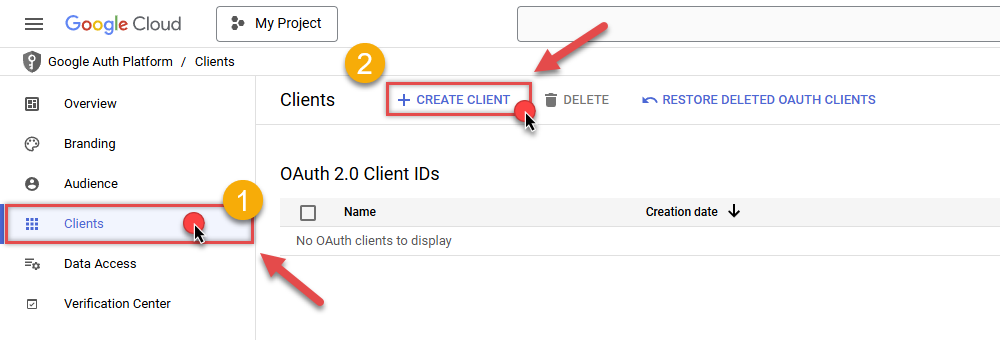
-
Choose
Desktop appas Application type and name your credentials: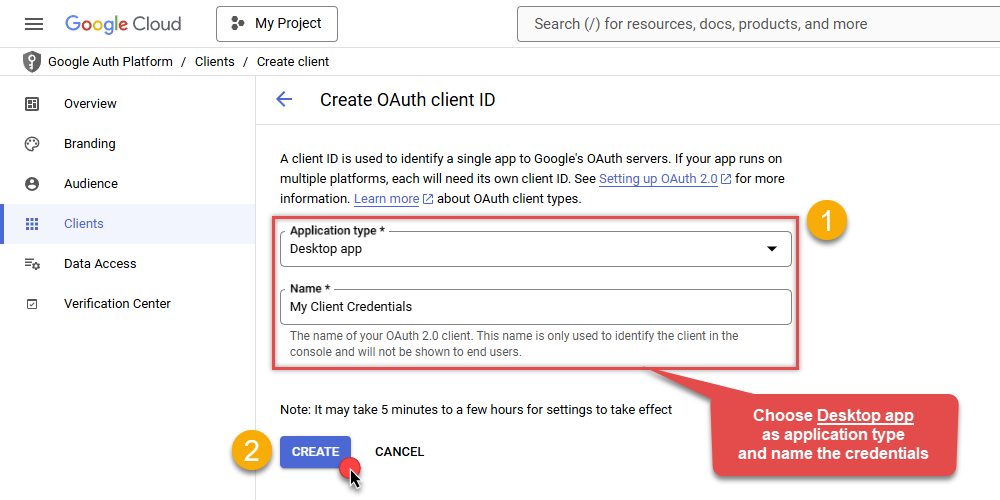
-
Continue by opening the created credentials:
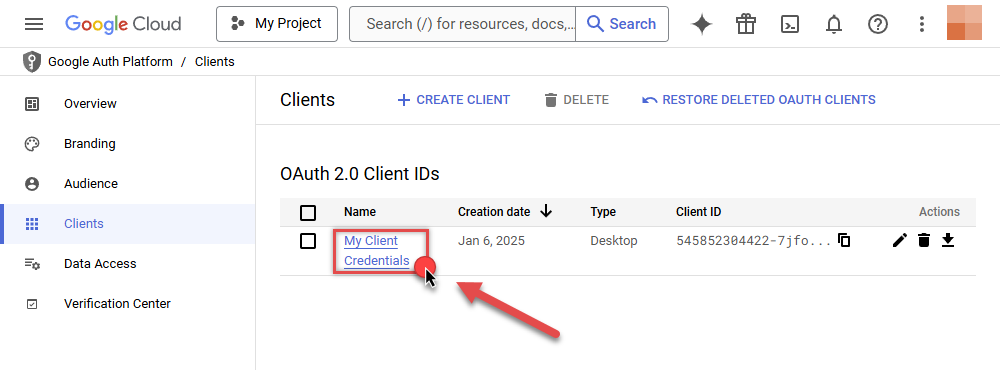
-
Finally, copy Client ID and Client secret for the later step:

- Done! We have all the data needed for authentication, let's proceed to the last step!
Step-5: Configure connection
-
Now go to SSIS package or ODBC data source and use previously copied values in User Account authentication configuration:
- In the ClientId field paste the Client ID value.
- In the ClientSecret field paste the Client secret value.
-
Press Generate Token button to generate Access and Refresh Tokens.
-
Finally, click Test Connection to confirm the connection is working.
- Done! Now you are ready to use Google Drive Connector!
API Connection Manager configuration
Just perform these simple steps to finish authentication configuration:
-
Set Authentication Type to
User Account [OAuth] - Optional step. Modify API Base URL if needed (in most cases default will work).
- Fill in all the required parameters and set optional parameters if needed.
- Press Generate Token button to generate the tokens.
- Finally, hit OK button:
GoogleDriveDSNGoogle DriveUser Account [OAuth]https://www.googleapis.com/Required Parameters UseCustomApp Fill-in the parameter... Optional Parameters ClientId ClientSecret Scope https://www.googleapis.com/auth/drive RetryMode RetryWhenStatusCodeMatch RetryStatusCodeList 403|429 RetryCountMax 5 RetryMultiplyWaitTime True Redirect URL (Only for Web App) 
Google Drive authentication
Service accounts are accounts that do not represent a human user. They provide a way to manage authentication and authorization when a human is not directly involved, such as when an application needs to access Google Cloud resources. Service accounts are managed by IAM. [API reference]
Follow these steps on how to create Service Account to authenticate and access Google Drive API in SSIS package or ODBC data source:
Step-1: Create project
This step is optional, if you already have a project in Google Cloud and can use it. However, if you don't, proceed with these simple steps to create one:
-
First of all, go to Google API Console.
-
Then click Select a project button and then click NEW PROJECT button:

-
Name your project and click CREATE button:

-
Wait until the project is created:

- Done! Let's proceed to the next step.
Step-2: Enable Google Drive API
In this step we will enable Google Drive API:
-
Select your project on the top bar:

-
Then click the "hamburger" icon on the top left and access APIs & Services:

-
Now let's enable several APIs by clicking ENABLE APIS AND SERVICES button:

-
In the search bar search for
driveand then locate and select Google Drive API:
-
Enable Google Drive API:

- Done! Let's proceed to the next step.
Step-3: Create Service Account
Use the steps below to create a Service Account in Google Cloud:
-
First of all, go to IAM & Admin in Google Cloud console:
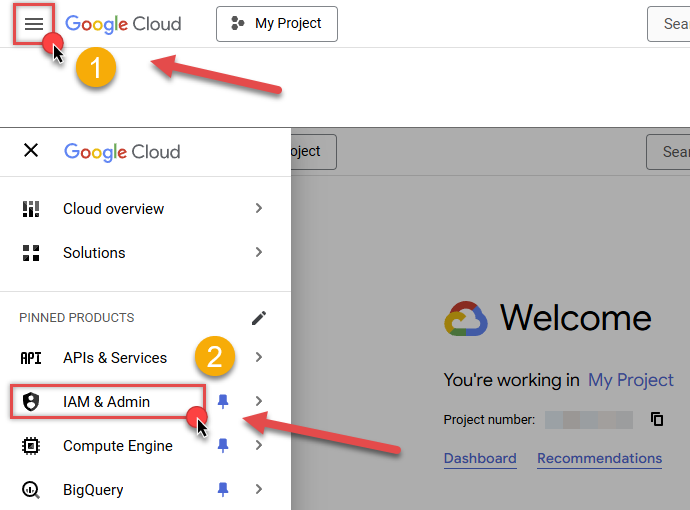
-
Once you do that, click Service Accounts on the left side and click CREATE SERVICE ACCOUNT button:
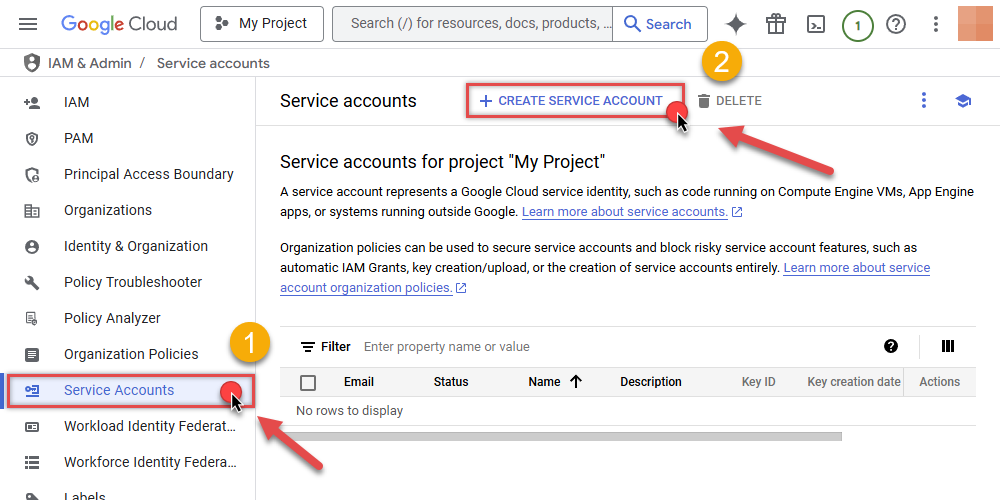
-
Then name your service account and click CREATE AND CONTINUE button:
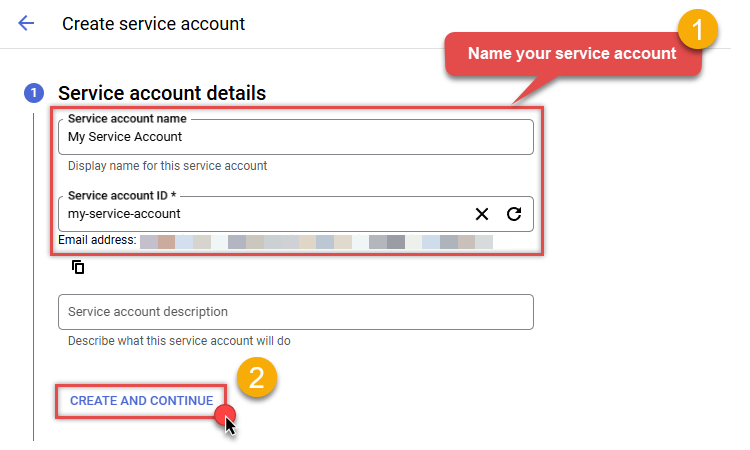
-
Continue by clicking Select a role dropdown and start granting service account Project Viewer roles:

-
Find Project group and select Viewer role:
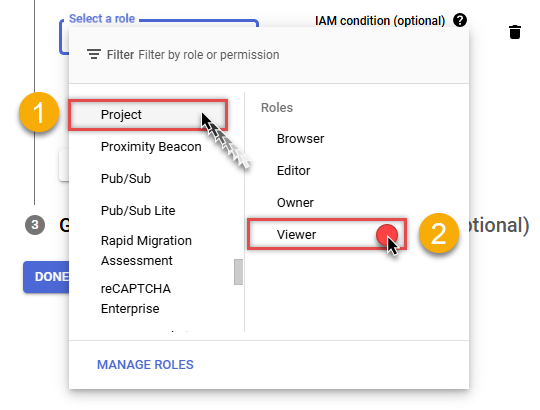
-
Finish adding roles by clicking CONTINUE button:
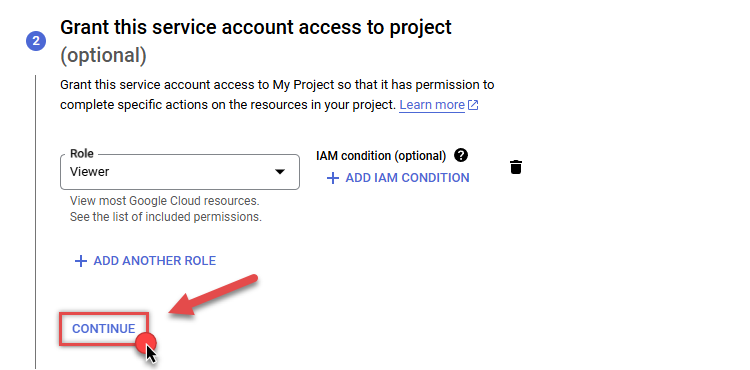 You can always add or modify permissions later in IAM & Admin.
You can always add or modify permissions later in IAM & Admin. -
Finally, in the last step, just click button DONE:

-
Done! We are ready to add a Key to this service account in the next step.
Step-4: Add Key to Service Account
We are ready to add a Key (JSON or P12 file) to the created Service Account:
-
In Service Accounts open newly created service account:
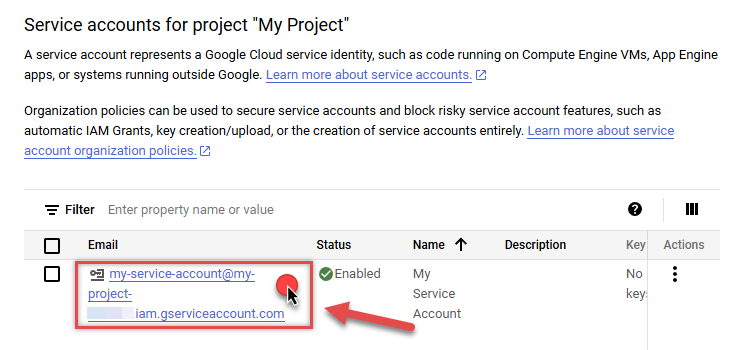
-
Next, copy email address of your service account for the later step:
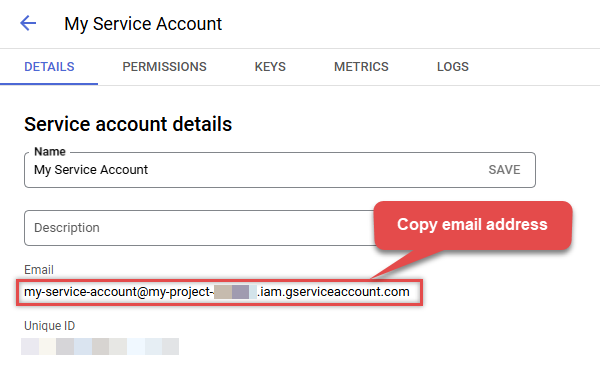
-
Continue by selecting KEYS tab, then press ADD KEY dropdown, and click Create new key menu item:

-
Finally, select JSON (Engine v19+) or P12 option and hit CREATE button:
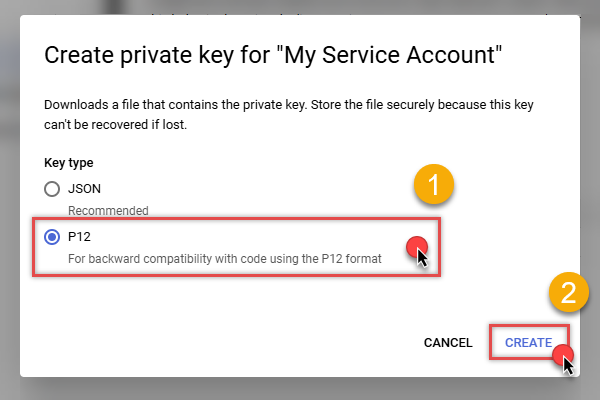
- Key file downloads into your machine. We have all the data needed for authentication, let's proceed to the last step!
Step-5: Share Google Drive files and folders with Service Account
Now it's time to grant Google Drive read/write permissions to the created service account:
- Login to https://drive.google.com with Google account credentials whose files/folders you want to share with the service account.
-
Select the file or folder, right-click on it, click Share menu item, and then hit Share subitem:
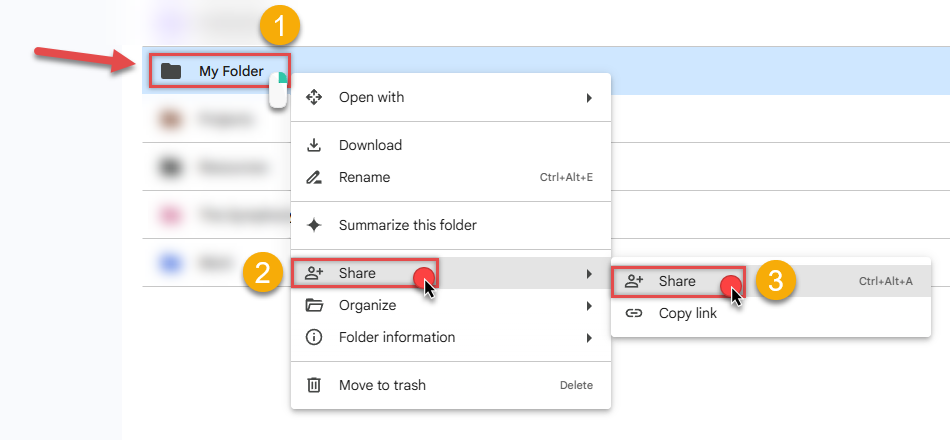
-
Share it with your service account:

-
Grant it appropriate permissions, e.g.
ViewerorEditor(for reading or writing):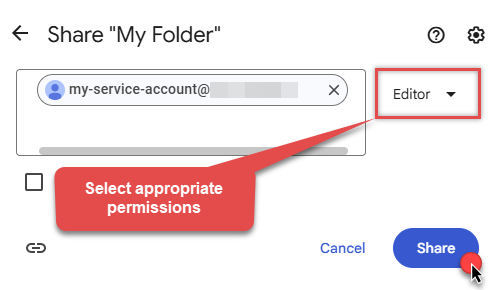
- That's it! Let's proceed to the configuration!
Step-6: Configure connection
-
Now go to SSIS package or ODBC data source and configure these fields in Service Account authentication configuration:
- In the Service Account Email field paste the service account Email address value you copied in the previous step.
- In the Service Account Private Key Path (i.e. *.json or *.p12) field use downloaded certificate's file path.
- Done! Now you are ready to use Google Drive Connector!
API Connection Manager configuration
Just perform these simple steps to finish authentication configuration:
-
Set Authentication Type to
Service Account (Using *.json OR *.p12 key file) [OAuth] - Optional step. Modify API Base URL if needed (in most cases default will work).
- Fill in all the required parameters and set optional parameters if needed.
- Finally, hit OK button:
GoogleDriveDSNGoogle DriveService Account (Using *.json OR *.p12 key file) [OAuth]https://www.googleapis.com/Required Parameters Service Account Email Fill-in the parameter... Service Account Private Key Path (i.e. *.json OR *.p12) Fill-in the parameter... Optional Parameters Scope https://www.googleapis.com/auth/drive RetryMode RetryWhenStatusCodeMatch RetryStatusCodeList 403|429 RetryCountMax 5 RetryMultiplyWaitTime True Impersonate As (Google account email address) 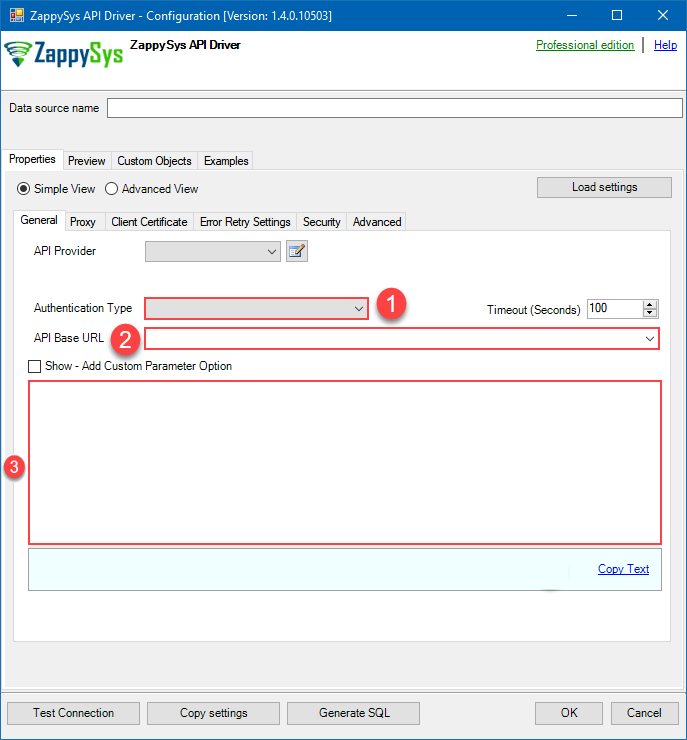
-
-
Once the data source connection has been configured, it's time to configure the SQL query. Select the Preview tab and then click Query Builder button to configure the SQL query:
 ZappySys API Driver - Google DriveRead / write Google Drive data inside your app; perform many Google Drive operations without coding, just using easy to use high performance API Connector for Google DriveGoogleDriveDSN
ZappySys API Driver - Google DriveRead / write Google Drive data inside your app; perform many Google Drive operations without coding, just using easy to use high performance API Connector for Google DriveGoogleDriveDSN
-
Start by selecting the Table or Endpoint you are interested in and then configure the parameters. This will generate a query that we will use in PowerShell to retrieve data from Google Drive. Hit OK button to use this query in the next step.
SELECT * FROM Drive Some parameters configured in this window will be passed to the Google Drive API, e.g. filtering parameters. It means that filtering will be done on the server side (instead of the client side), enabling you to get only the meaningful data
Some parameters configured in this window will be passed to the Google Drive API, e.g. filtering parameters. It means that filtering will be done on the server side (instead of the client side), enabling you to get only the meaningful datamuch faster . -
Now hit Preview Data button to preview the data using the generated SQL query. If you are satisfied with the result, use this query in PowerShell:
 ZappySys API Driver - Google DriveRead / write Google Drive data inside your app; perform many Google Drive operations without coding, just using easy to use high performance API Connector for Google DriveGoogleDriveDSN
ZappySys API Driver - Google DriveRead / write Google Drive data inside your app; perform many Google Drive operations without coding, just using easy to use high performance API Connector for Google DriveGoogleDriveDSNSELECT * FROM Drive You can also access data quickly from the tables dropdown by selecting <Select table>.A
You can also access data quickly from the tables dropdown by selecting <Select table>.AWHEREclause,LIMITkeyword will be performed on the client side, meaning that thewhole result set will be retrieved from the Google Drive API first, and only then the filtering will be applied to the data. If possible, it is recommended to use parameters in Query Builder to filter the data on the server side (in Google Drive servers). -
Click OK to finish creating the data source.
Video Tutorial
Read Google Drive data in PowerShell
Sometimes, you need to quickly access and work with your Google Drive data in PowerShell. Whether you need a quick data overview or the complete dataset, this article will guide you through the process. Here are some common scenarios:
Viewing data in a terminal- Quickly peek at Google Drive data
- Monitor data constantly in your console
- Export data to a CSV file so that it can be sliced and diced in Excel
- Export data to a JSON file so that it can ingested by other processes
- Export data to an HTML file for user-friendly view and easy sharing
- Create a schedule to make it an automatic process
- Store data internally for analysis or for further ETL processes
- Create a schedule to make it an automatic process
- Integrate data with other systems via external APIs
In this article, we will delve deeper into how to quickly view the data in PowerShell terminal and how to save it to a file. But let's stop talking and get started!
Reading individual fields
- Open your favorite PowerShell IDE (we are using Visual Studio Code).
-
Then simply follow these instructions:
"DSN=GoogleDriveDSN"
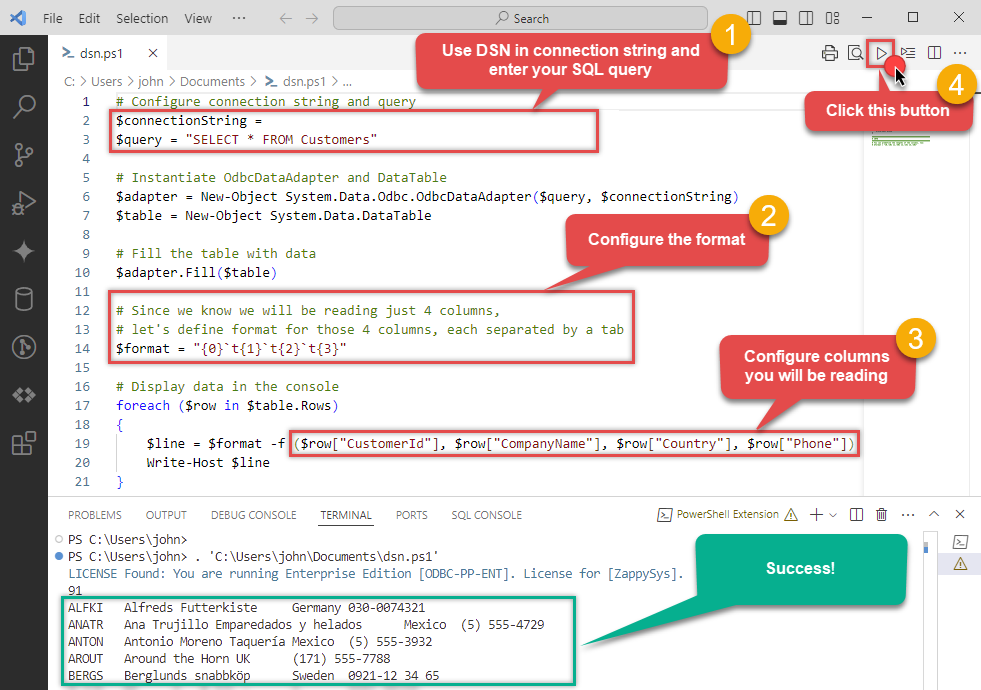
For your convenience, here is the whole PowerShell script:
# Configure connection string and query $connectionString = "DSN=GoogleDriveDSN" $query = "SELECT * FROM Customers" # Instantiate OdbcDataAdapter and DataTable $adapter = New-Object System.Data.Odbc.OdbcDataAdapter($query, $connectionString) $table = New-Object System.Data.DataTable # Fill the table with data $adapter.Fill($table) # Since we know we will be reading just 4 columns, let's define format for those 4 columns, each separated by a tab $format = "{0}`t{1}`t{2}`t{3}" # Display data in the console foreach ($row in $table.Rows) { # Construct line based on the format and individual Google Drive fields $line = $format -f ($row["CustomerId"], $row["CompanyName"], $row["Country"], $row["Phone"]) Write-Host $line }Access specific Google Drive table field using this code snippet:
You will find more info on how to manipulate$field = $row["ColumnName"]DataTable.Rowsproperty in Microsoft .NET reference.For demonstration purposes we are using sample tables which may not be available in Google Drive. -
To read values in a console, save the script to a file and then execute this command inside PowerShell terminal:
 You can also use even a simpler command inside the terminal, e.g.:
You can also use even a simpler command inside the terminal, e.g.:. 'C:\Users\john\Documents\dsn.ps1'
Retrieving all fields
However, there might be case, when you want to retrieve all columns of a query. Here is how you do it:
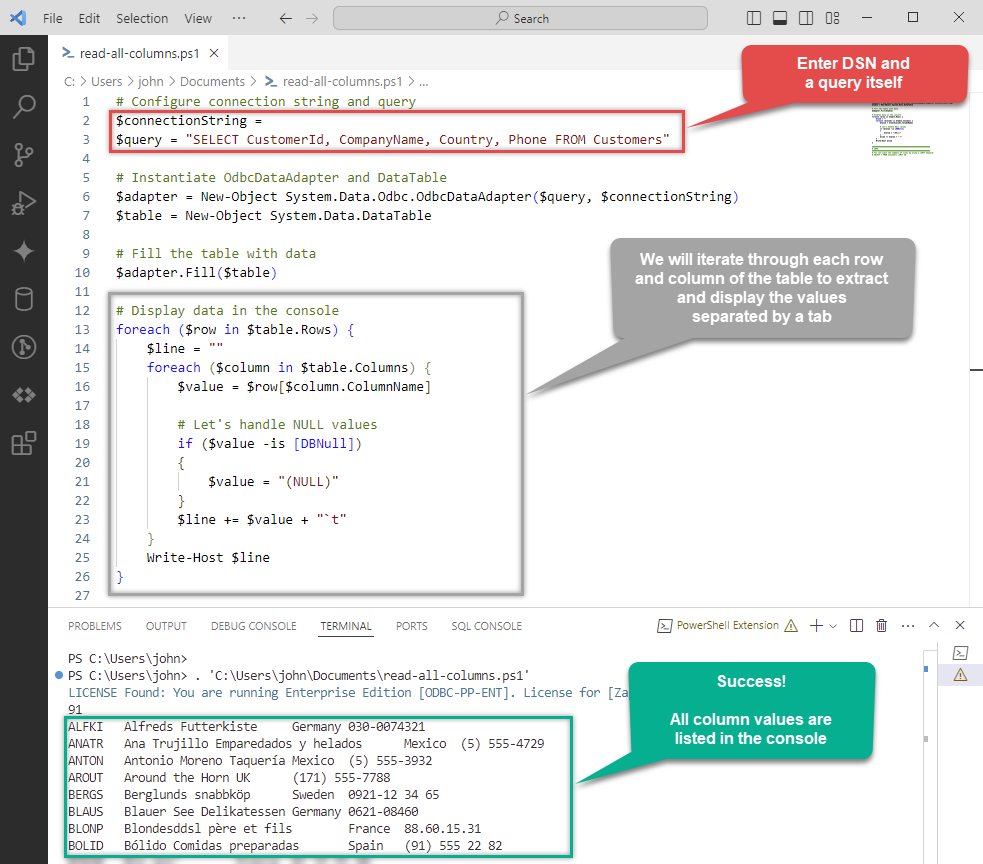
Again, for your convenience, here is the whole PowerShell script:
# Configure connection string and query
$connectionString = "DSN=GoogleDriveDSN"
$query = "SELECT CustomerId, CompanyName, Country, Phone FROM Customers"
# Instantiate OdbcDataAdapter and DataTable
$adapter = New-Object System.Data.Odbc.OdbcDataAdapter($query, $connectionString)
$table = New-Object System.Data.DataTable
# Fill the table with data
$adapter.Fill($table)
# Display data in the console
foreach ($row in $table.Rows) {
$line = ""
foreach ($column in $table.Columns) {
$value = $row[$column.ColumnName]
# Let's handle NULL values
if ($value -is [DBNull])
{
$value = "(NULL)"
}
$line += $value + "`t"
}
Write-Host $line
}
LIMIT keyword in the query, e.g.:
SELECT * FROM Customers LIMIT 10Using a full ODBC connection string
In the previous steps we used a very short format of ODBC connection string - a DSN. Yet sometimes you don't want a dependency on an ODBC data source (and an extra step). In those times, you can define a full connection string and skip creating an ODBC data source entirely. Let's see below how to accomplish that in the below steps:
-
Open ODBC data source configuration and click Copy settings:
 ZappySys API Driver - Google DriveRead / write Google Drive data inside your app; perform many Google Drive operations without coding, just using easy to use high performance API Connector for Google DriveGoogleDriveDSN
ZappySys API Driver - Google DriveRead / write Google Drive data inside your app; perform many Google Drive operations without coding, just using easy to use high performance API Connector for Google DriveGoogleDriveDSN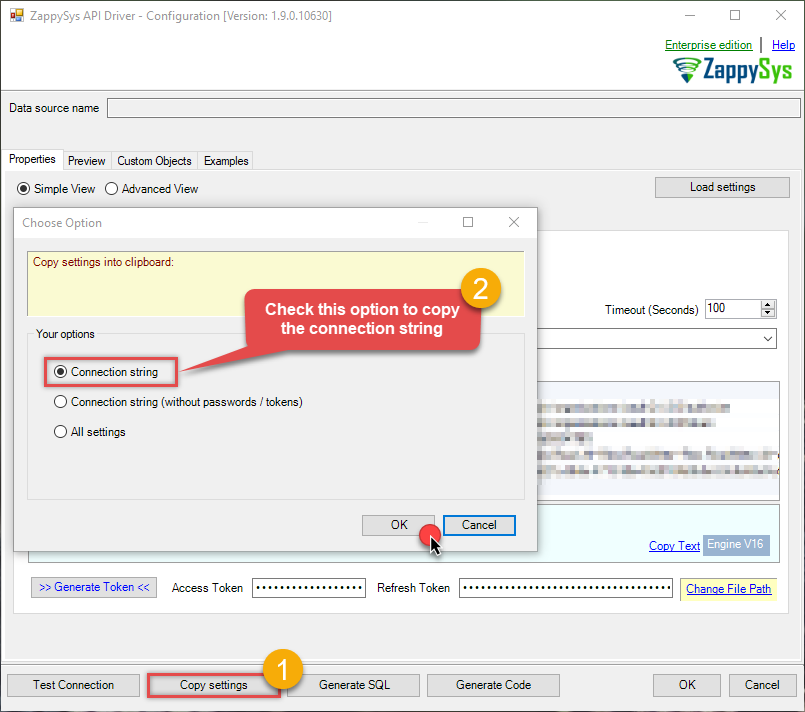
-
The window opens, telling us the connection string was successfully copied to the clipboard:

-
Then just paste the connection string into your script:

- You are good to go! The script will execute the same way as using a DSN.
Have in mind that a full connection string has length limitations.
Proceed to the next step to find out the details.
Limitations of using a full connection string
Despite using a full ODBC connection string may be very convenient it comes with a limitation: it's length is limited to 1024 symbols (or sometimes more). It usually happens when API provider generates a very long Refresh Token when OAuth is at play. If you are using such a long ODBC connection string, you may get this error:
"Connection string exceeds maximum allowed length of 1024"But there is a solution to this by storing the full connection string in a file. Follow the steps below to achieve this:
- Open your ODBC data source.
- Click Copy settings button to copy a full connection string (see the previous section on how to accomplish that).
- Then create a new file, let's say, in C:\temp\odbc-connection-string.txt.
- Continue by pasting the copied connection string into a newly created file and save it.
-
Finally, the last step! Just construct a shorter ODBC connection string using this format:
DRIVER={ZappySys API Driver};SettingsFile=C:\temp\odbc-connection-string.txt - Our troubles are over! Now you should be able to use this connection string in PowerShell with no problems.
Write Google Drive data to a file in PowerShell
Save data to a CSV file
Export data to a CSV file so that it can be sliced and diced in Excel:
# Configure connection string and query
$connectionString = "DSN=GoogleDriveDSN"
$query = "SELECT * FROM Customers"
# Instantiate OdbcDataAdapter and DataTable
$adapter = New-Object System.Data.Odbc.OdbcDataAdapter($query, $connectionString)
$table = New-Object System.Data.DataTable
# Fill the table with data
$adapter.Fill($table)
# Export table data to a file
$table | ConvertTo-Csv -NoTypeInformation -Delimiter "`t" | Out-File "C:\Users\john\saved-data.csv" -ForceSave data to a JSON file
Export data to a JSON file so that it can ingested by other processes (use the above script, but change this part):
# Export table data to a file
$table | ConvertTo-Json | Out-File "C:\Users\john\saved-data.json" -ForceSave data to an HTML file
Export data to an HTML file for user-friendly view and easy sharing (use the above script, but change this part):
# Export table data to a file
$table | ConvertTo-Html | Out-File "C:\Users\john\saved-data.html" -ForceConvertTo-Csv, ConvertTo-Json, and ConvertTo-Html for other data manipulation scenarios.
Actions supported by Google Drive Connector
Learn how to perform common Google Drive actions directly in PowerShell with these how-to guides:
- Create a folder
- Delete all items
- Delete an item
- Download a file
- Duplicate a file
- Empty trash
- Export a file
- Get file info
- Get my drive info
- List deleted files / folders
- List files (Recursive)
- List files / folders from a parent folder (Recursive)
- List folders
- Lists shared drives
- Replace file data (keep same file id)
- Search items (i.e. files / folders)
- Update metadata in a file
- Upload a file
- Upload a file (with overwrite action)
- Make Generic API Request
- Make Generic API Request (Bulk Write)
Conclusion
In this article we showed you how to connect to Google Drive in PowerShell and integrate data without any coding, saving you time and effort.
We encourage you to download Google Drive Connector for PowerShell and see how easy it is to use it for yourself or your team.
If you have any questions, feel free to contact ZappySys support team. You can also open a live chat immediately by clicking on the chat icon below.
Download Google Drive Connector for PowerShell Documentation











































































